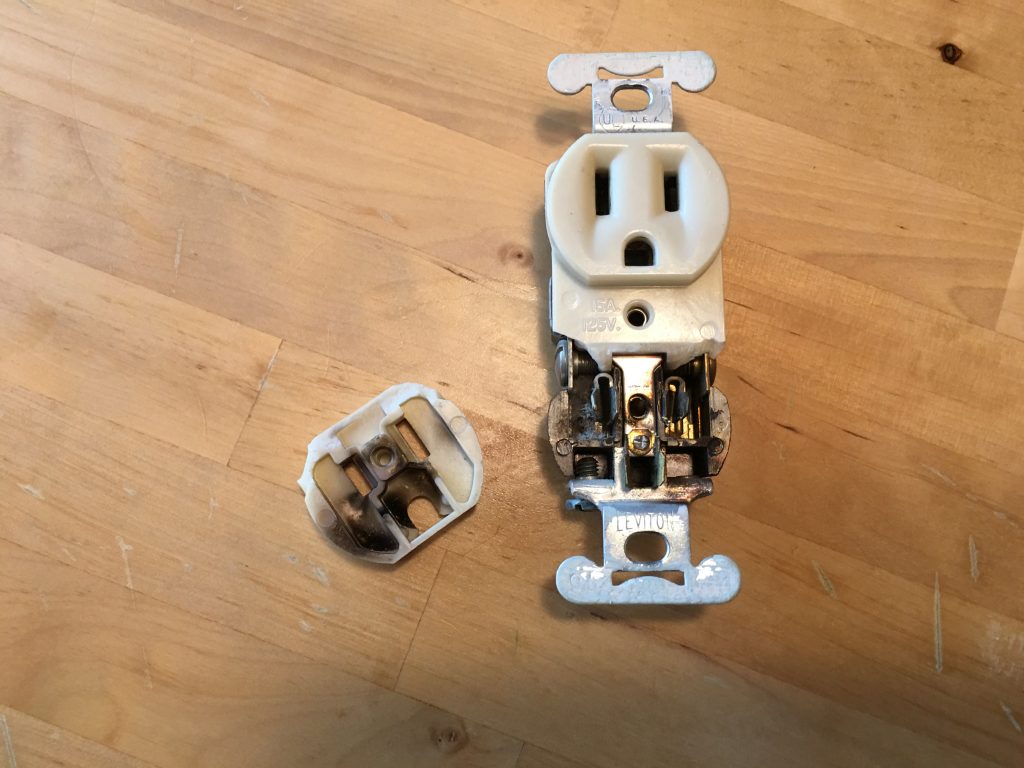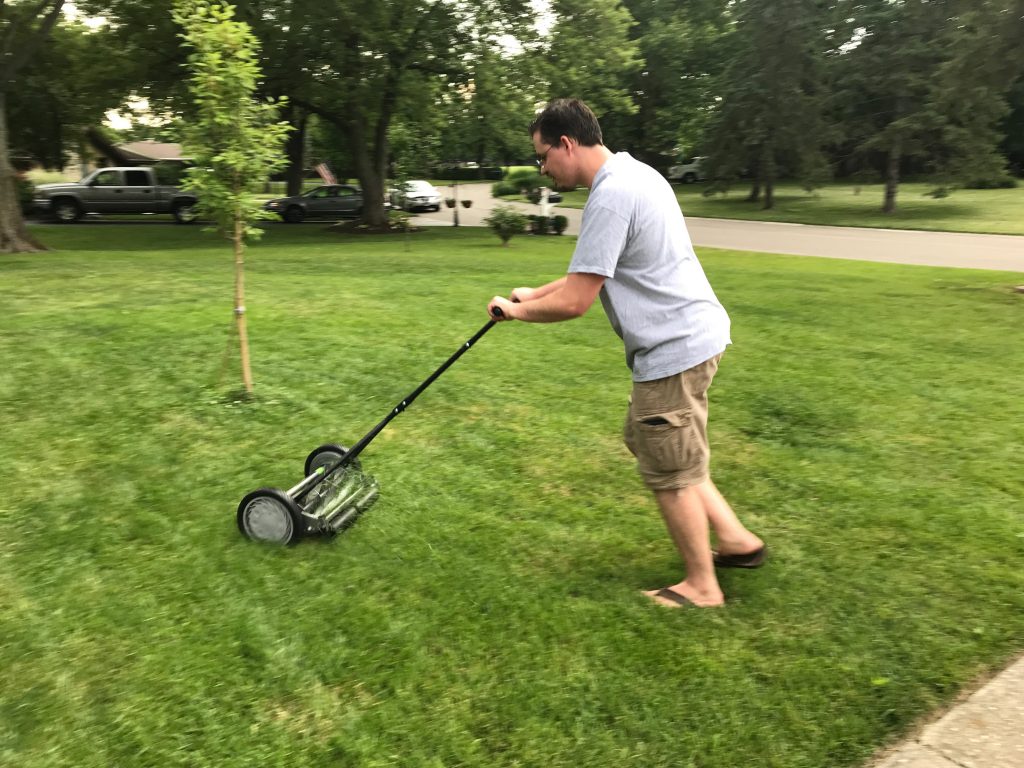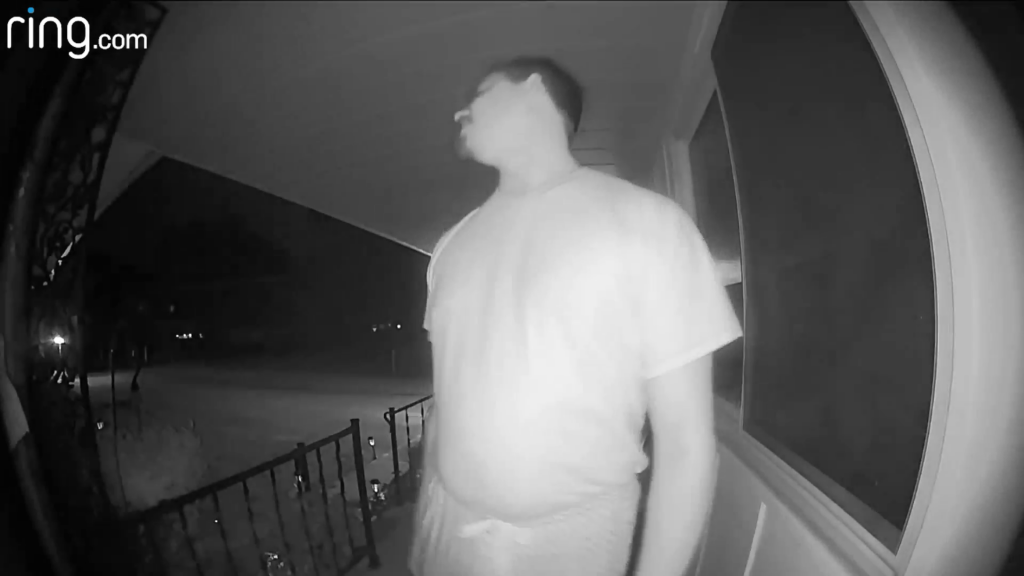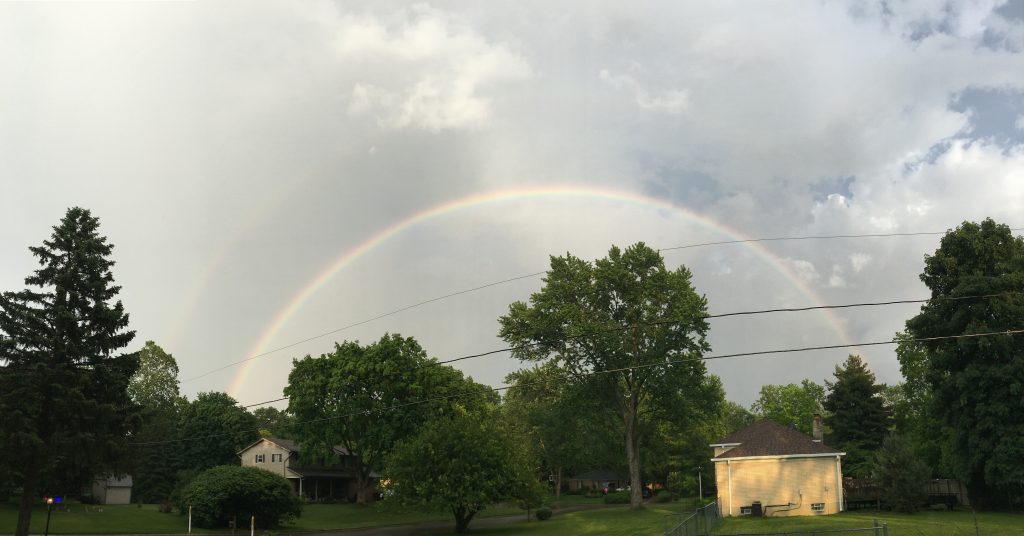This one’s a quick post–just sharing the results of a failed electrical outlet that short-circuited when I unplugged the clothes steamer:

As the title states: ZAP!
(No husbands were harmed in the making of this post)
–Simon

Tales from Easement Acres
This one’s a quick post–just sharing the results of a failed electrical outlet that short-circuited when I unplugged the clothes steamer:

As the title states: ZAP!
(No husbands were harmed in the making of this post)
–Simon
My very early memories of Dad mowing the lawn were of the reel mower variety. At the time, this was San Diego and a small rental property. After the move to Lubbock, however, the reel mower very quickly was replaced with what we now know as the “standard” gasoline-powered rotary mower. I understand the size of the new lawn and the toughness of that southern Bermuda had a hand in the decision to switch. I was too young to give much thought to the matter, and that heavy, noisy steel goliath eventually became my own baptism into the world of lawn-mowing. And I hated every minute of it.
And that damn mower made the move to Toledo, and my continued misery in a now far more humid climate. I certainly never missed the chore after moving out.
Then we bought a house and I was required to revive my long-reviled domestic duty and purchase a mower. And since the gas mower was all I knew, that’s what I bought (although 20 years had led to a few more technological advancements in fuel economy and weight). So once again, in the miserably-humid summers of Ohio, I push a noisy hunk of steel and aluminum across a half acre of grass in a suburban ritual of begrudging duty (yet steadfastly opposed to hiring a landscaping company to do the task for me). And I hate every minute of it.
But humanity’s collective attention span is short, and the pendulum has begun swinging back. Whispers of a better mower began to emanate from the Internet’s consciousness, and I remembered Dad’s old mower. So I began asking, for I had been too young to mow when my parents had abandoned the reel mower. Surely someone has a positive memory of using such antiquated and manual technology.
I asked Liz. I think her response was something along the lines of “That sucked” or “Fuck that” or “Hell no”, or some variant of vulgar discontent. Then again, mowing would of course be unpleasantly remembered by anyone who had to mow the lawn as a youth, despite the equipment involved, because no kid ever in the history of ever has enjoyed chores. So for a more impartial opinion less steeped in vindictive bias, I consulted the Village Elder.
But his response was about the same. In fact, he was the one who tried to convince me that I should buy a riding mower when we moved in. So in the end, I knew no one who had a positive anecdote, and the idea drifted from mind.
Then Father’s Day arrived. Liz, with her always half-ironic mentality, gave me a modern reel mower. And just like that, the discussion saw resolution. I would use one of these despised icons of American lawn maintenance of yore.
I carried the contraption out to the yard (it weighs about 25 pounds), placed it in the grass, and pushed. The metal on metal squeal was louder than expected, but eventually I realized that the blades needed adjusting. I backed them away from the cutting bar slightly, and the squeal lessened. And, the mower became much easier to push.

In fact, it was significantly easier to push then a gas mower. That was unexpected. It also cut cleaner. But most importantly, it’s quiet, meaning I can cut the lawn late in the evening and avoid the brutal sun of the midwestern afternoon. And since there’s no deadly spinning sword of death below, I don’t have to worry about gearing up with proper footwear prior to using it. And it doesn’t require gas. And the grass grows back quicker now. I guess that could be good or bad, depending on perspective, but I imagine it indicates a healthier lawn. In fact, the only real downside is that it’s not as wide, so more passes are required, and since there’s no vortex action, some of the grass doesn’t always get pulled up into the blades.
But apart from these two downsides, I find that the advantages far outweigh the drawbacks. And, while I’ll never win the power equipment arms race against my neighbors, I’m happy to win pretentiousness points.
In all seriousness, I don’t know why more people don’t use these, apart from bad childhood memories and gas mowers being the current default. I tried to explain the benefits to my neighbors, but they laughed and continue to jeer me from afar, mocking me openly for my apparent naive stupidity. Ah well. I’m just happy that the core’s misery has been lessened.
–Simon
It was a dark and dreary night (that’s how these stories begin). The relentless rain saw fit to maximize my misery, but I stood stoically indifferent, for my mind was concerned with more important matters. I withdrew and attempted to light a cigarette in the darkness as water dripped from my fedora and down the length of my tan trenchcoat. The Zippo stubbornly refused cooperation, having been dropped in the gutter a moment prior. It could have very well been my last smoke, but it was not meant to be.
A sudden gust of wind sent a chill through my bones, though the subsequent shiver was more from anxiety over events to come, rather than from the weather itself. Giving up on the cigarette, I placed it back in its pack, steeled my nerves, and knocked on the door.
Okay, that’s not exactly how it happened. Here I am in an undershirt and pajamas on my front porch, trying to coerce someone within to wake and open the door:

The back door, one of those of the irritating sliding variety (going to be replaced with a French door one day), had one of those equally-irritating locking mechanisms in which the user must flip a switch to engage a hook against a notch. But unlike a standard deadbolt, the user has no form of immediate feedback that the lock has successfully engaged, as the switch will still flip even when the lock is shy of the frame, thus necessitating the user to test the lock by attempting to open the door. If the door opens, it must be slammed shut and the lock tried again.
And my door, being ancient, requires much force to turn the lock, resulting in a repeated slam/push/switch/pull maneuver until the pull results in a stuck door, thus indicating a successfully-engaged lock.
The point being, that it’s impossible to accidentally lock oneself out of the house via the back door.
But as it turns out (after much subsequent testing), that if the lock is engaged before the door is shut, that the hook will simply bounce over and into the notch, thus locking the door. This method had never occurred to me, for who would lock a door before closing it?
But on this night, someone had done just that. I know not which girl to blame, for both are equally inept at locking doors and windows. Many a time have I realized that a bedroom window had been unlocked for an unknown period of time. So now my lockdown procedures involve checking every single window lock every single morning, which considerably delays my morning departure time.
But anyway, this night–the night of the ineffectually-locked back door–it had started to rain. It was late, around 11, and I was drifting off to some Twilight Zone. I realized the grill hadn’t been covered, so I went out to do just that. I opened the back door, closed it, covered the grill, and attempted to re-enter my abode via said back door. And the door had locked itself. And I found myself standing outside in pajamas without keys or phone, and it was raining. And I had recently completed my rounds wherein I lock all the windows that previously had been unlocked by one of the girls. In short, there was no way in.
So I rang the doorbell, and heard its distinctive chime emanating from my phone upon the coffee table. I had counted on the alarm waking Liz, but she had apparently imbibed in some horse-tranquilizers (or laudanum–I dunno quizzicallywhat she takes, but it sure does knock her out), and remained unconscious through the screeching cacophony. I considered trying to wake the kid, but refrained. It was apparent I was going to have to bang on a bedroom window, and such a terrifying means by which to be awoken should be reserved for my one true love.
I hammered on the bedroom window and yelled, at once thankful that we lived on a dead-end. And eventually, a face cautiously peered from around the curtain. A worried and bewildered face–the kind awoken from the wrong sleep cycle.
The lesson: leave another avenue for entrance when wandering out into the night. And get a velociraptor mask, because that totally would have been worth being locked outside until morning.
–Simon
Our Memorial Day weekend campfire got postponed a day on account of more rain, but we received our first double rainbow of the year as a result.

Happy Memorial Day!
–Simon
Alas, we’ve received our first Spring rainbow. It isn’t epic–it’s humble and modest, yet bold in stature. Unassumingly low on the horizon, but wide.

–Simon